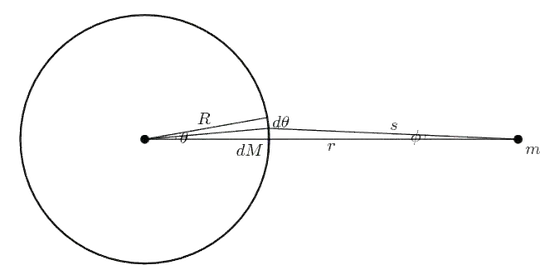Converse shell theorem for an exterior point mass:
Assume that the force ${\bf F}_{12}$ between two point masses $m_1$ and $m_2$ is collinear with the difference in positions ${\bf r}_{12}:={\bf r}_1-{\bf r}_2$, is central, and the magnitude
$$|{\bf F}_{12}|=m_1m_2 f(|{\bf r}_{12}|)\tag{*}$$
is proportional to both the two point masses. We call the function $f(|{\bf r}_{12}|)$ the specific force.
Assume furthermore that the magnitude of the total force between an extended spherically symmetric mass $M$ and an exterior point mass $m$ is of the same form $$|{\bf F}|=mM f(r),\tag{**}$$
where $r\equiv |{\bf r}|$ is the distance between $m$ and the center of $M$.
Then the specific force $f$ is a linear combination of
Sketched proof: Let us use the same notation as the Wikipedia page. We consider the outside of a thin shell, i.e. $r\geq R$.

Let us for simplicity work in terms of potential energy (rather than force), because it is easier to work with a scalar (rather than a vector) quantity. We may assume that the contribution $dU$ to the potential energy of the mass $m$ and $dM$ with distance $s$ is of the form
$$ dU~=~m~dM~u(s),\tag{1.1}$$
where $s\mapsto u(s)$ is an unknown specific potential. Define for later convenience the antiderivative
$$V(s)~:=~\int^s\! ds^{\prime}~s^{\prime}~ u(s^{\prime}),
\tag{1.2}$$
so that
$$V^{\prime}(s)~\stackrel{(1.2)}{=}~s~u(s).\tag{1.3}$$
From geometry we have the cosine relation
$$ \cos\theta ~=~\frac{r^2+R^2-s^2}{2rR},\tag{1.4} $$
and therefore
$$dM ~=~ \frac{M}{2}\sin\theta~ d\theta
~=~-\frac{M}{2}~d\cos(\theta)
~\stackrel{(1.4)}{=}~\frac{M}{2}\frac{s~ds}{rR}.\tag{1.5}$$
In the last equality of eq.(1.5) we varied $s$ and $\theta$ while holding $r$ and $R$ fixed. Then we have
$$dU~\stackrel{(1.1)+(1.5)}{=}~\frac{mM}{2}\frac{s~ds}{rR}~u(s)
~\stackrel{(1.3)}{=}~\frac{mM}{2rR}ds~V^{\prime}(s).\tag{1.6}$$
So the total potential energy is
$$U(r,R)~=~\int dU
~\stackrel{(1.6)}{=}~mM\frac{V(r+R)-V(r-R)}{2rR}$$
$$~\stackrel{(1.8)}{=}~\frac{mM}{r}\left(V^{\prime}(r)+ \frac{R^2}{6}V^{\prime\prime\prime}(r)+ {\cal O}(R^5)\right).\tag{1.7}$$
In the last equality of eq. (1.7), we Taylor-expanded the potential
$$V(r\pm R)~=~V(r) \pm RV^{\prime}(r) + \frac{R^2}{2}V^{\prime\prime}(r) \pm \frac{R^3}{6}V^{\prime\prime\prime}(r)+ {\cal O}(R^4). \tag{1.8}$$
Let us now implement the main converse shell assumption: We assume that the potential energy $U(r,R)$ up to an ambiguity in the choice of zero-point energy $U_0(R)$ does not depend on the radius $R$ of the thin shell, i.e. $U(r,R)$ is of the form
$$U(r,R)~=~U_1(r)+U_0(R) .\tag{1.9} $$
We see that the only way that eq. (1.7) could be of the form (1.9) is iff
$$ V^{\prime\prime\prime}(r)~\stackrel{(1.7)+(1.9)}{\propto}~r,\tag{1.10} $$
i.e. $V^{\prime}$ is a 3rd-order polynomial with a missing 2nd-order term:
$$ V^{\prime}(r)~\stackrel{(1.10)}{=}~Ar^3+Br^2+Cr+D\tag{1.11}, \qquad B~=~0. $$
Or in terms of the specific potential
$$ u(r)~\stackrel{(1.3)+(1.11)}{=}~Ar^2+C+\frac{D}{r}\tag{1.12}. $$
Or in terms of the specific force
$$ -f(r)~=~u^{\prime}(r)~\stackrel{(1.12)}{=}~2Ar-\frac{D}{r^2}\tag{1.13}. $$
$\Box$
